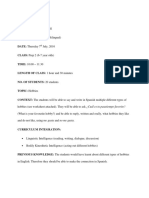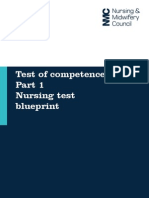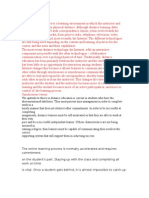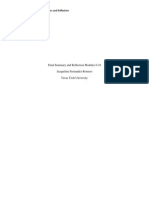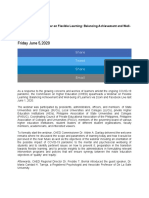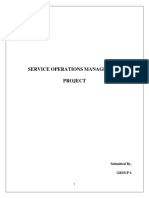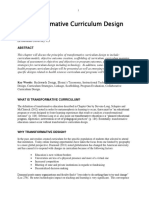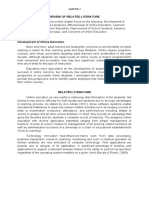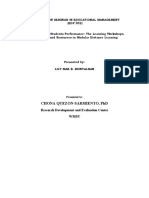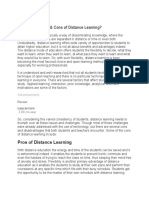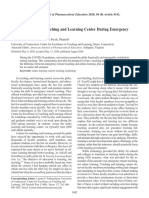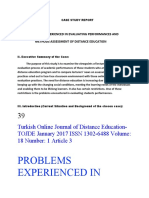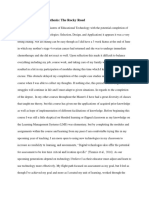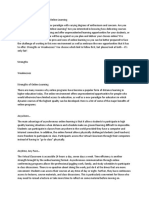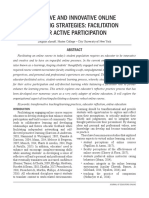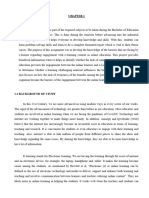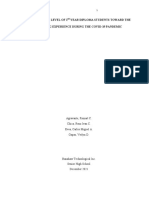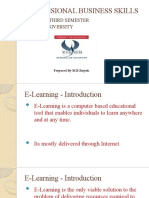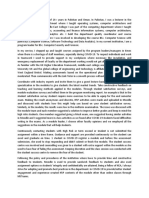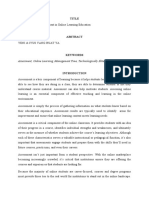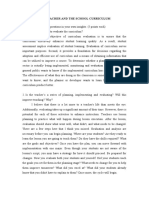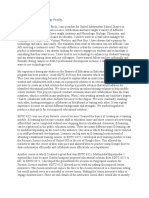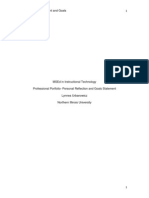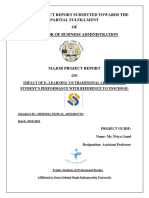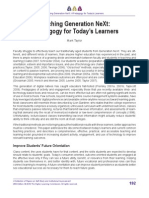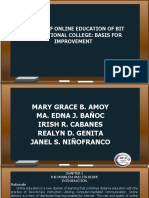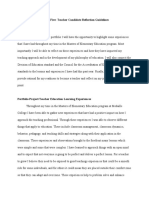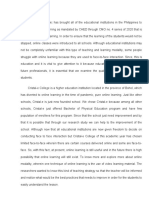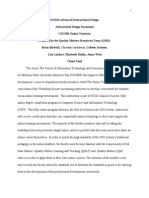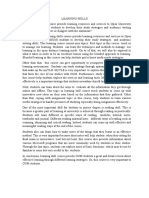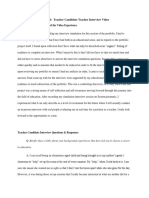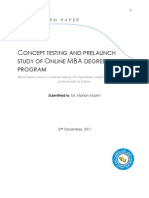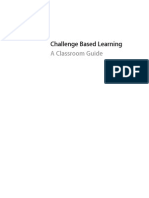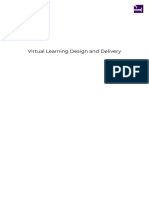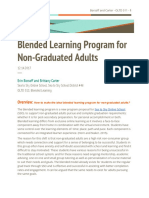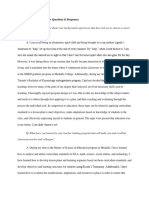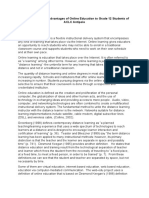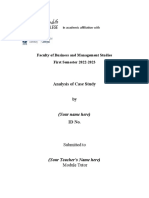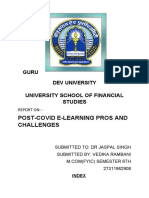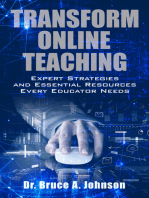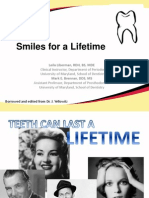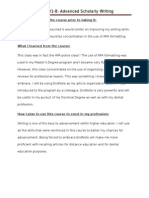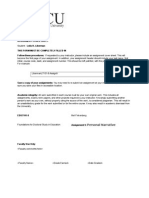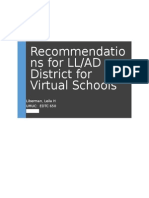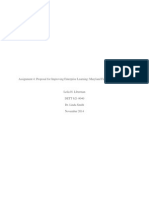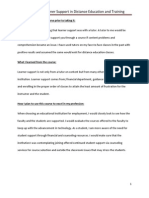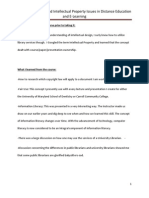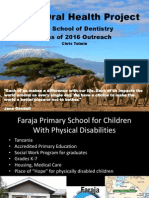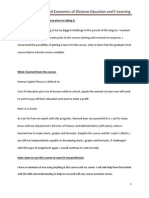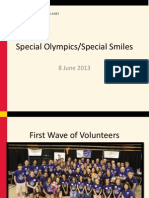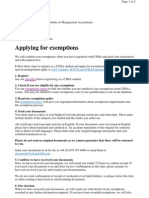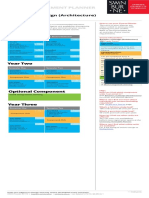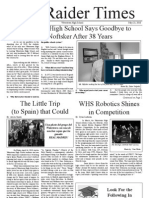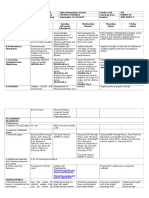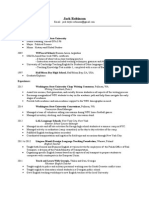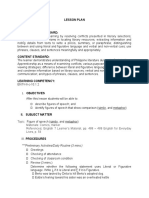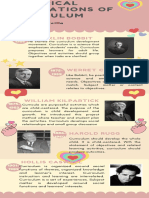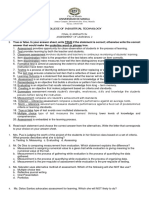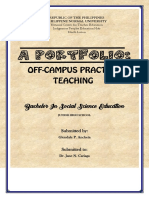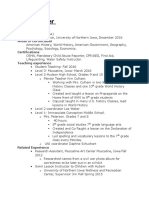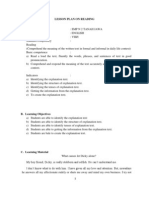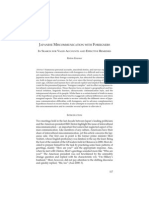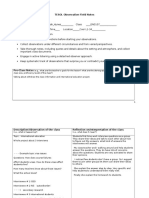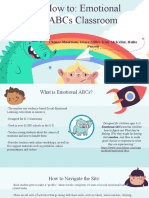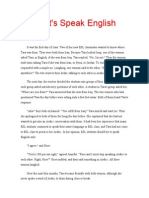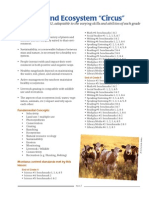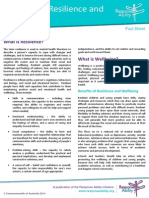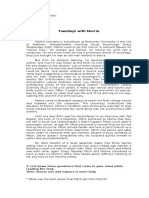Professional Documents
Culture Documents
Omde 601
Omde 601
Uploaded by
api-241955651Original Title
Copyright
Available Formats
Share this document
Did you find this document useful?
Is this content inappropriate?
Report this DocumentCopyright:
Available Formats
Omde 601
Omde 601
Uploaded by
api-241955651Copyright:
Available Formats
OMDE 601: Foundations of Distance Education and E-Learning
What I knew about the course prior to taking it: NOTHING!!! This was my first online course toward my Masters in Distance Education and I had no clue what it would entail! I knew there would be a lot of reading, research and participationbut that was all. I knew I had my mentor by my side and could ask anything of her! I knew my family would stand behind me, as well, and I knew I needed a Masters Degree to advance as a full time faculty member at the University of Maryland, School of Dentistry. What I learned from the course:
One of the many responsibilities of an instructor is to help a student overcome subject matter that they are having problems understanding, and to help them accept the correct concept. All students are due respect and courtesy to have an assessment of their knowledge of the course concepts, as well as the ability to provide their positive and negative attributes of the course. Assessment of both the faculty and student support systems must be in place and evaluated at the conclusion of the course. These evaluations should be used when performing yearly faculty reviews. Sadly, some faculty members see the administration of an online course as inferior to traditional courses Perreault (2008). Many important actions are needed to facilitate successful student learning via distance education. Course development for distance education classes can be formulated by one of two models; author/editor or a team approach. Communication is more important than in a standard classroom and involves technology and feedback from the instructors and fellow students enrolled in the distance education course. Administration requirements of a distance education course are also extremely more involved than in a traditional classroom atmosphere. Industrial production and consumption of a distance education course must be carefully contemplated to promote success. Communication is vital and highly attainable through the advancement of the 1
OMDE 601: Foundations of Distance Education and E-Learning
digital world. Standardizing a course is topic specific. Mass production can be successful once the target audience is identified. We are taught early in life that planning is essential to prosper. As with distance education, planning is essential to produce the utmost quality course. As the world evolves, the industrial age is being replaced with the digital/informational age; however, education is a business and someone must make money.
How I plan to use this course to excel in my profession:
I have learned that a DE course requires interaction between students and instructors. I have learned the importance of using different media to add to student learning in a Blackboard course. I have learned that the course I took to be licensed to administer local anesthetic was considered a hybrid/blended DE course. I have been teaching an Oral Radiography course at Carroll Community College (CCC). Many of the aspects of student relations and media will be beneficial to the students at CCC. I plan to integrate these components into my future courses. Examples of changes I will make include: adding videos to my Oral Radiography course; adding video links to my ppt lectures; develop more thread discussions on Blackboard. Because leaning must be hands on to be affective, the online portion of the course will be integrated into the simulation lab. Thus making it a blended or hybrid course.
Perreault, H., Waldman, L., Alesander, M., Zhao, J. (2008). Comparing the Distance LearningRelated Course Development Approach and Faculty Support and Rewards Structure at AACSB Accredited Intuitions between 2001 and 2006. The Journal of Educators Online, 5(2), 1-15.
You might also like
- Spanish Lesson Plan HobbiesDocument10 pagesSpanish Lesson Plan Hobbiesapi-361516539100% (4)
- Test of Competence - Part One - Nursing Test BlueprintDocument133 pagesTest of Competence - Part One - Nursing Test BlueprintApril Palantog100% (7)
- ConclusionDocument7 pagesConclusionEng Jye NgNo ratings yet
- Final Summary and Reflection Modules 6-10Document8 pagesFinal Summary and Reflection Modules 6-10api-264575628No ratings yet
- Omde 608 Assignment 3 - DavisDocument8 pagesOmde 608 Assignment 3 - Davisapi-298237027No ratings yet
- CHED Conducts Blended Learning WebinarDocument12 pagesCHED Conducts Blended Learning WebinarMark Anthony Nieva RafalloNo ratings yet
- Service Operations Management Project: Submitted By, Group 6Document14 pagesService Operations Management Project: Submitted By, Group 6SoorajKrishnanNo ratings yet
- Chapter FiveDocument2 pagesChapter FiveJocel Ellen-May OrillaNo ratings yet
- CowellDocument13 pagesCowellapi-349364249No ratings yet
- Program Reflection EssayDocument13 pagesProgram Reflection Essayapi-207706766No ratings yet
- Chapter 2 Transformative Curriculum Design EDIT2Document50 pagesChapter 2 Transformative Curriculum Design EDIT2Noey TabangcuraNo ratings yet
- Distance LearningDocument4 pagesDistance LearningVillamor Lanas Jhon LloydNo ratings yet
- Distance Learning and Effect On Practical Skills Courses in BTVTED of ZCSPCDocument12 pagesDistance Learning and Effect On Practical Skills Courses in BTVTED of ZCSPCMae CherryNo ratings yet
- Review of Related LiteratureDocument5 pagesReview of Related LiteraturenyakNo ratings yet
- 302 Paper MaeDocument26 pages302 Paper MaePhantom ThiefNo ratings yet
- Pros and Cons of Distance LearningDocument5 pagesPros and Cons of Distance Learningjemarwin domogenNo ratings yet
- Commentary Perspective From A Teaching and Learning Center During Emergency Remote TeachingDocument3 pagesCommentary Perspective From A Teaching and Learning Center During Emergency Remote TeachingandersonNo ratings yet
- Case Study ReportDocument17 pagesCase Study ReportBriel SanchezNo ratings yet
- Final Synthesis Kevin LowDocument7 pagesFinal Synthesis Kevin Lowapi-464449682No ratings yet
- Blended CourseworkDocument4 pagesBlended Courseworkbcrqy80d100% (2)
- Strengths and Weaknesses of Online LearningDocument6 pagesStrengths and Weaknesses of Online LearningAllan TomasNo ratings yet
- Article To Analyze - Category and FunctionDocument9 pagesArticle To Analyze - Category and FunctionRETVIA BUNGA ALVENTY Pendidikan Bahasa InggrisNo ratings yet
- Research MethodDocument22 pagesResearch Methodrichardbrayan1997No ratings yet
- Blended Learning: F. Tañedo Street Cor. Mcarthur Highway, Tarlac City, Philippines 2300 Email Address: WebsiteDocument8 pagesBlended Learning: F. Tañedo Street Cor. Mcarthur Highway, Tarlac City, Philippines 2300 Email Address: Websiteclara dupitasNo ratings yet
- Ortiz S TPDP 2Document66 pagesOrtiz S TPDP 2api-464335930No ratings yet
- (Cogtas & Subito - Bsed-2e (Action Researc ProposalDocument4 pages(Cogtas & Subito - Bsed-2e (Action Researc ProposalEthel Khae D. CogtasNo ratings yet
- Chapter I-V Edited FormatDocument28 pagesChapter I-V Edited FormatMark Clarence MateoNo ratings yet
- Nadia Isnkandar - Research The Effectiveness of Web-Based Training of Elearning On Students SatisfactionDocument28 pagesNadia Isnkandar - Research The Effectiveness of Web-Based Training of Elearning On Students SatisfactionnadiaNo ratings yet
- Professional Business Skills-E LearningDocument52 pagesProfessional Business Skills-E LearningrajeshmanamNo ratings yet
- Teaching ExperienceDocument2 pagesTeaching ExperienceRaza HassanNo ratings yet
- Artikel Jurnal 85%Document14 pagesArtikel Jurnal 85%Widya Nur AfiatiNo ratings yet
- Anotche Clarise B. The Teacher and The School Curriculum Final ExamDocument5 pagesAnotche Clarise B. The Teacher and The School Curriculum Final ExamJemma Rose TegioNo ratings yet
- Birch Reflection LetterDocument3 pagesBirch Reflection Letterapi-281965445No ratings yet
- Conlon 1997Document11 pagesConlon 1997AngelooNo ratings yet
- Online Education and Traditional Education EducationDocument5 pagesOnline Education and Traditional Education EducationRAVITEJA TELUGARANo ratings yet
- Portfolio-Professional Statement and GoalsDocument10 pagesPortfolio-Professional Statement and Goalsapi-235551194No ratings yet
- Acfrogc D9kynqg6107p-9xkb80dsv1bschs Xtptwasaulvy-8omy 2azbsdxaydzdsi8a99qhrwahuitgmp Bzmtagpurndf9cq2dwzx4pfqz84f7bvrcwgo7ufb-Xd7lph7pvbdohjwevpahaDocument68 pagesAcfrogc D9kynqg6107p-9xkb80dsv1bschs Xtptwasaulvy-8omy 2azbsdxaydzdsi8a99qhrwahuitgmp Bzmtagpurndf9cq2dwzx4pfqz84f7bvrcwgo7ufb-Xd7lph7pvbdohjwevpahaDeepak KaushikNo ratings yet
- Teaching GNDocument5 pagesTeaching GNnaaneninnaNo ratings yet
- RESEARCHDocument12 pagesRESEARCHnadiaNo ratings yet
- Quality of Online EducationDocument23 pagesQuality of Online EducationMa Edna J. BañocNo ratings yet
- Section Five: Teacher Candidate Reflection GuidelinesDocument9 pagesSection Five: Teacher Candidate Reflection Guidelinesapi-518796492No ratings yet
- Kearl O. Mandao RSDocument24 pagesKearl O. Mandao RSKearl MandaoNo ratings yet
- Online Teaching PhilosophyDocument4 pagesOnline Teaching Philosophyapi-99570533No ratings yet
- Impact of Online TeachingDocument16 pagesImpact of Online TeachingJhanzaib HassanNo ratings yet
- U01a1 Audience&environmentalanalysis StirlingDocument6 pagesU01a1 Audience&environmentalanalysis Stirlingapi-281661547No ratings yet
- 1 of 5 17TH Annual Conference On Distance Teaching and LearningDocument5 pages1 of 5 17TH Annual Conference On Distance Teaching and Learningapi-295665506No ratings yet
- Intoduction, RRL, RRSDocument8 pagesIntoduction, RRL, RRSFlora Mae ArbuyesNo ratings yet
- Ist626 Qms 1 8Document58 pagesIst626 Qms 1 8api-265092619No ratings yet
- Learning SkillsDocument5 pagesLearning SkillsCikgu KaviNo ratings yet
- Section 6Document5 pagesSection 6api-469878907No ratings yet
- Concept Testing and Prelaunch Study of Online Mba Degree ProgramDocument42 pagesConcept Testing and Prelaunch Study of Online Mba Degree ProgramNumair Imran0% (1)
- What Is Remote LearningDocument8 pagesWhat Is Remote LearningKevin LOZANO RAMIREZNo ratings yet
- CBL Classroom Guide Jan 2011 PDFDocument40 pagesCBL Classroom Guide Jan 2011 PDFMultazeem MominNo ratings yet
- Virtual LearningDocument199 pagesVirtual LearningPepe AguiarNo ratings yet
- Major Project Oltd 511Document15 pagesMajor Project Oltd 511api-425373425No ratings yet
- In Education.: Teacher Candidate Interview Questions & ResponsesDocument3 pagesIn Education.: Teacher Candidate Interview Questions & Responsesapi-469878907No ratings yet
- Advantages and Disadvantages of Online Education To Grade 12 Students of ACLC AntipoloDocument4 pagesAdvantages and Disadvantages of Online Education To Grade 12 Students of ACLC AntipoloJane Sandoval0% (1)
- Barriers of Blended LearningDocument7 pagesBarriers of Blended LearningSamreenNo ratings yet
- Know The Technology: Tips HereDocument13 pagesKnow The Technology: Tips HereZahjid CallangNo ratings yet
- Guru Nanak Dev UniversityDocument17 pagesGuru Nanak Dev UniversityAnimesh salhotraNo ratings yet
- Online Assignment: Need and Importance of Website, Educational CD'S, and Learning ModuleDocument7 pagesOnline Assignment: Need and Importance of Website, Educational CD'S, and Learning ModulesujithasabiNo ratings yet
- Transform Online Teaching: Expert Strategies and Essential Resources Every Educator NeedsFrom EverandTransform Online Teaching: Expert Strategies and Essential Resources Every Educator NeedsRating: 5 out of 5 stars5/5 (2)
- Leila SeniorsDocument20 pagesLeila Seniorsapi-241955651No ratings yet
- Edu 7001Document1 pageEdu 7001api-241955651No ratings yet
- Edu 7101Document1 pageEdu 7101api-241955651No ratings yet
- Libermanl7101-8assign 9Document8 pagesLibermanl7101-8assign 9api-241955651No ratings yet
- Llibermana 4Document16 pagesLlibermana 4api-241955651No ratings yet
- Mission 2014Document10 pagesMission 2014api-241955651No ratings yet
- Interview TwoDocument16 pagesInterview Twoapi-241955651No ratings yet
- Dett 621 9040 SyllabusDocument30 pagesDett 621 9040 Syllabusapi-241955651No ratings yet
- Libermanl A4Document17 pagesLibermanl A4api-241955651No ratings yet
- Omde 608Document1 pageOmde 608api-241955651No ratings yet
- Omde 610Document3 pagesOmde 610api-241955651No ratings yet
- Dett 611Document2 pagesDett 611api-241955651No ratings yet
- Dett 607Document2 pagesDett 607api-241955651No ratings yet
- No Tshirt Pic Faraja January 2013Document8 pagesNo Tshirt Pic Faraja January 2013api-241955651No ratings yet
- Omde 606Document1 pageOmde 606api-241955651No ratings yet
- of The EventDocument9 pagesof The Eventapi-241955651No ratings yet
- 4a's Detailed Lesson Plan in Grade 9 - Arts A. Learning Competency/iesDocument7 pages4a's Detailed Lesson Plan in Grade 9 - Arts A. Learning Competency/iesANGELCIA VILANo ratings yet
- Applying For Exemptions - CimaDocument2 pagesApplying For Exemptions - CimaKevin EidelmanNo ratings yet
- BA-ARC Hawthorn Classroom BasedDocument1 pageBA-ARC Hawthorn Classroom BasedmorhafNo ratings yet
- WHS02472 May 10Document17 pagesWHS02472 May 10The Boston GlobeNo ratings yet
- Thematic UnitDocument18 pagesThematic Unitapi-291742957100% (2)
- BSED 4 Year StudentDocument12 pagesBSED 4 Year StudentMichael CalaramoNo ratings yet
- Mapeh DLL q2 Wk5Document9 pagesMapeh DLL q2 Wk5Nota BelzNo ratings yet
- Post Harvest Tech (Short)Document15 pagesPost Harvest Tech (Short)Lokesh AhirwarNo ratings yet
- PUP Grad Tracer Study 1 2Document3 pagesPUP Grad Tracer Study 1 2Michael Olmedo NeneNo ratings yet
- Jack Robinson Resume 2015Document2 pagesJack Robinson Resume 2015api-281993498No ratings yet
- Lesson Plan (Figure Os Speech)Document3 pagesLesson Plan (Figure Os Speech)Honeycue Portoza AlmazolNo ratings yet
- Historical FoundationDocument2 pagesHistorical FoundationJoenephel ArdienteNo ratings yet
- Final Examination - Assessment 2Document5 pagesFinal Examination - Assessment 2Doc Joey100% (4)
- PMPDocument3 pagesPMPRon0% (1)
- Certificate Course CMA EngineersDocument8 pagesCertificate Course CMA EngineersMani Rathinam RajamaniNo ratings yet
- LB Engleza11 LongmanDocument218 pagesLB Engleza11 LongmanBalintTigram100% (1)
- Final Final Final WohooooDocument41 pagesFinal Final Final WohooooJohn Clyde RanchezNo ratings yet
- Mathematics Achievers in Albay - Stories of Success and ChallengesDocument14 pagesMathematics Achievers in Albay - Stories of Success and ChallengesGlobal Research and Development ServicesNo ratings yet
- Diana Baker Resume 2015Document3 pagesDiana Baker Resume 2015api-306953546No ratings yet
- Lesson Plan On ReadingDocument4 pagesLesson Plan On ReadingNurLan Muthina TumorangNo ratings yet
- Japan Miscommunication With ForeignersDocument35 pagesJapan Miscommunication With ForeignersDjoTomNo ratings yet
- Eng 107 3 30 2016 Tesol Observation Field NotesDocument4 pagesEng 107 3 30 2016 Tesol Observation Field Notesapi-306853222No ratings yet
- Emotional AbcsDocument8 pagesEmotional Abcsapi-549664113No ratings yet
- Lets Speak English UNIT 1Document11 pagesLets Speak English UNIT 1Marcela JuarezNo ratings yet
- Montana Ecology Education Lesson Plan 2: Ecology and Ecosystem Grades 3 - 12Document4 pagesMontana Ecology Education Lesson Plan 2: Ecology and Ecosystem Grades 3 - 12Montana Association of Conservation DistrictsNo ratings yet
- Promoting Resilience and Wellbeing FinalDocument4 pagesPromoting Resilience and Wellbeing Finalapi-268625907No ratings yet
- Tuesdays With Morrie, Reaction PaperDocument3 pagesTuesdays With Morrie, Reaction PaperNyaaawNo ratings yet
- Business Revitalization - A Research PaperDocument7 pagesBusiness Revitalization - A Research Paperrohit_mehndiNo ratings yet
